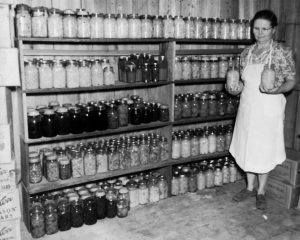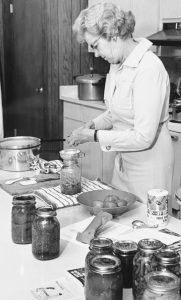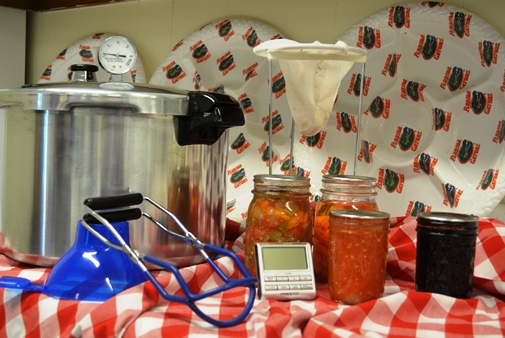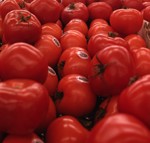
by Terri Keith | Feb 21, 2021

Homemade canned preserves 1942.
Photo Credits: UF/IFAS File Photo
In 1795, Napoleon needed a better way to preserve large quantities of food for his troops during the Napoleonic Wars, so his government offered a reward of 12,000 francs for the invention of a new food preservation method. In 1809, Nicolas Appert won that award with his canning technique that used glass containers that were sealed then heated to a set temperature. Peter Durand created the tin canister a year later. These inventions led to the canning materials and processes that are used today to preserve food for people all over the world.
Canned food provides a convenient and often less expensive way to include fruits and vegetables in the diet of many individuals and families. Canned foods are also considered a staple in many pantries because of their shelf life. Commercially canned products may keep the food packed inside at its best quality for 1 to 5 years depending on the type of food. Most home canned foods are able to be stored for up to a year, though there are some exceptions.

Photo Credit: UF/IFAS Photo by Tyler Jones
To make the most of canned foods, keep these tips in mind.
Best by or use by dates on commercial products do not indicate safety. They are estimated dates provided by the manufacturer on how long they believe their product would be at its best quality. The exception to this is for infant formula products that are required to have a “Use-By” date and should not be used after that date.
Avoid cans or jars that are not in good condition. Look for dents, swelling or bulging, leaking, rust, cracks in jars or loose lids. If the food has a foul odor or spurts liquid when it’s opened, do not use it. Any of these could indicate the food may have been contaminated or could contain Clostridium botulinum toxins.

A woman canning in the kitchen.
Photo Credits: UF/IFAS File Photo
Store canned foods in a cool, dark and dry space. This will help them to last longer and keep the food inside at its best quality. Keep canned foods in an area that is between 50-70°F.
Use canned foods to fill nutrition gaps. Add a can of vegetables to your dinner menu—a side of green beans or carrots can help balance your plate. Try using a can of fruit as a basis for a dessert. Pineapple and cottage cheese, anyone? If you’re concerned about sodium or sugar in canned foods, look for products marked as low sodium or lite for less sugar. Compare ingredient and nutrition labels of different brands or varieties of a product to find what works best for you.
If you can foods at home, make sure you’re following recipes that have been tested for safety. Follow the guidelines in the USDA Complete Guide to Home Canning, 2015 Revision or find more information at the National Center for Home Food Preservation. You can also contact your local extension office; in Florida, you can find your local office here.
Resources:
U.S. Department of Agriculture, National Agricultural Library, How Did We Can?: https://www.nal.usda.gov/exhibits/ipd/canning/timeline-table
U.S. Department of Agriculture, AskUSDA, How long can you keep canned goods?: https://ask.usda.gov/s/article/How-long-can-you-keep-canned-goods
U.S. Department of Agriculture, Food Safety and Inspection Service, Food Product Dating: https://www.fsis.usda.gov/wps/portal/fsis/topics/food-safety-education/get-answers/food-safety-fact-sheets/food-labeling/food-product-dating/food-product-dating
by Shelley Swenson | Mar 29, 2015

Get your pressure canner ready for the season.
Photo by Les Harrison, Wakulla County
In addition to planting your spring garden and reviewing the latest food safety materials, you should consider having your pressure canner gauge tested. Today’s pressure canner may have a dial gauge for indicating the pressure or a weighted gauge, for indicating and regulating the pressure.
Weighted gauges will either keep rocking gently or make a frequent jiggling noise to indicate that the correct pressure is being maintained. Read the manufacturer’s instructions to know how a particular weighted gauge should rock or jiggle. Weighted gauges do not require testing.
Check dial gauges for accuracy before use each year. Gauges that read high cause under-processing and may result in unsafe food. Low readings cause over-processing. Pressure adjustments can be made if the gauge reads up to 2 pounds high or low. Replace gauges that differ by more than 2 pounds.
Many UF/IFAS Extension Offices have pressure gauge testers and are willing to test yours for accuracy. It is always best to call for an appointment to insure that the FCS Agent is going to be in when you arrive. Don’t remove the gauge but bring the entire lid. If you prefer or if you find that your extension office does not offer this service, Presto will test gauges at no charge. For more information, phone Presto Customer Service: 1-800-877-0441 or contact@gopresto.com.
Handle canner lid gaskets carefully and clean them according to the manufacturer’s directions. Nicked or dried gaskets will allow stem leaks during pressurization of canners. Keep gaskets clean between uses. Gaskets on older model canners may require a light coat of vegetable oil once per year. Gaskets on newer model canners are pre-lubricated and do not benefit from oiling. Check you canner’s instructions if there is doubt that the particular gasket you use has been pre-lubricated.
Lid safety fuses are thin metal inserts or rubber plugs designed to relieve excessive pressure from the canner. Do not pick at or scratch fuses while cleaning. Use only canners that have the Underwriter’s Laboratory (UL) approval to ensure their safety.
Replacement gauges and other parts are often found at stores that sell food preservation equipment or from canner manufacturers. When ordering parts, be sure to provide your canner model number and describe the parts that you need.
Remember, pressure does not destroy microorganisms, but high temperatures applied for an adequate period of time do kill microorganisms. The success of destroying all microorganisms capable of growing in low-acid, canned food is based on the temperature obtained in pure steam, free of air, at sea level. At sea level, a canner operated at a gauge of 10.5 pounds provides an internal temperature of 240o.
For more information, contact your County Extension Family and Consumer Sciences Agent.
by Kendra Hughson | Jul 23, 2012
Tomatoes are the most popular vegetable in backyard gardens. With each plant capable of producing 8-10 pounds of fruit or more, good gardeners may have more tomatoes than they can eat. If you lack a green thumb, tomatoes are easy to find at farmers markets, roadside stands, and even grocery stores.
Botanically, the tomato is a fruit but in 1893 the U.S. Supreme Court declared the tomato a vegetable because of a tariff dispute. Nutritionally, tomatoes are low in calories and fat and high in vitamin C and potassium. They are good source of vitamin A in the form of beta carotene. Tomatoes are also high in the antioxidant, lycopene. Research has shown that lycopene may reduce the risk of heart disease and several types of cancer. Lycopene is more easily absorbed from cooked tomato products. Eighty percent of the lycopene in the American diet comes from tomato products.
There is nothing tastier than a freshly picked tomato. Choose tomatoes that are firm, fragrant, and brightly colored. Avoid bruised tomatoes that are too soft or too hard. Store tomatoes at room temperature, and only refrigerate tomatoes to keep them longer. Fresh tomatoes are good in salads, on sandwiches, or tossed on scrambled eggs, nachos, or in other common dishes like macaroni and cheese.
Tomatoes are easy to preserve by freezing, drying, or canning.
FREEZING
Frozen tomatoes are mushy when thawed but can be used in soups and casseroles. Wash and dip tomatoes in boiling water for 30 seconds to loosen skins. Core and peel. Freeze whole or in pieces. Pack in freezer containers, jars, or packaging, leaving 1- inch headspace.
Cooked Puree. Wash, peel, core, and cut tomatoes. Cook until soft. Press through food mill or sieve. Cool and pack into freezer jars or containers. Concentrate the puree by boiling until amount is reduced in half.
Juice. Wash, core, peel, and cut tomatoes. Simmer about 5 minutes; put through a sieve or food mill. Cool and pack as above.
DRYING
Small cherry tomatoes or tomatoes with a high solid content, such as Romas, work best for drying. Dried tomatoes are good in soups, stews, sauces, and salads. Tomato leather can be eaten as is, added to soups for flavor, or a little water can be added to the leather to make a savory tomato sauce. Steam tomatoes for 3 minutes or dip tomatoes in boiling water for 1 minute to loosen skins. Chill in cold water; slip skins off. Cut into sections about 1/2 inch wide or slices; cut small tomatoes in half. Dry tomatoes in a food dehydrator for approximately10-18 hours (length of time depends on initial moisture content). Follow the manufacturer’s instructions.
CANNING
Tomatoes are a low-acid food and must be canned carefully to avoid the risk of botulism. To acidify tomatoes, add 1 tablespoon bottled lemon juice, 1/4 teaspoon citric acid, OR 2 tablespoons vinegar per pint jar. For quarts, add 2 tablespoons bottled lemon juice, 1/2 teaspoon citric acid, OR 4 tablespoons vinegar per jar. The acid can be added directly to each jar before filling with the product. Add a little sugar to offset any strong acid taste. Tomatoes can be processed using a boiling water bath or a pressure canner. Use only tested recipes and current canning recommendations from the National Center for Home Food Preservation (http://nchfp.uga.edu/).
Whole or halved raw tomatoes packed in water:
Add two tablespoons bottled lemon juice to each clean quart jar and fill with peeled, raw whole or halved tomatoes. Cover tomatoes in jar with hot water leaving ½ inch headspace. Wipe off jar rim. Adjust pretreated lids and screw ring onto jar, finger tight. Process quarts for 45 minutes in a boiling water bath. If you use a dial-gauge pressure canner, process for 10 minutes at 11 pounds pressure With a weighted gauge canner, process 10 minutes at 10 pounds pressure.
RECIPE:
Fresh Garden Salsa
The ingredients can be finely diced or use a medium chopped consistency for chunky salsa. Serve with tortilla chips or use as a side dish with grilled meat or anywhere you want a bright, tart, savory accompaniment.
2 large ripe, red slicing tomatoes, cored and chopped
1 small white onion, chopped
1 green onion, top included, chopped
1 to 3 jalapeno peppers, finely chopped
1/4 cup cilantro leaves, minced
Juice of lime
teaspoon salt
1. Using a serrated knife, chop tomatoes. If using plum tomatoes, add 2 tablespoons water.
2. In a medium bowl, toss together the tomatoes, onions, peppers, and cilantro. Squeeze lime juice over the mixture and sprinkle on the salt. Allow to rest 30 minutes before serving to allow salt to draw juice from the tomatoes. Stir again just before serving. Makes about 2 cups.
For more information about growing or preserving tomatoes or other produce, contact the UF/IFAS Leon County Extension office at 850-606-5200, or your local Extension office.
Author: Kendra Zamojski, County Extension Director and Family and Consumer Sciences Agent, UF/IFAS Leon County Extension






